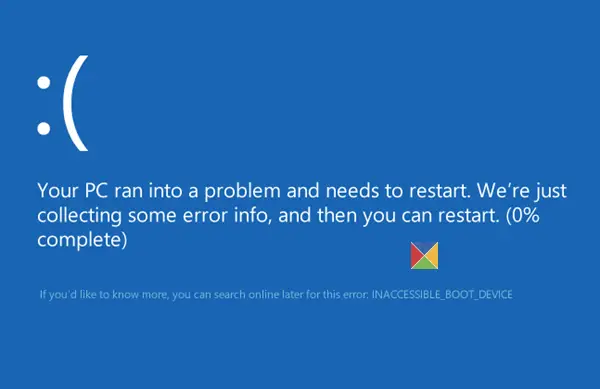The INACCESSIBLE BOOT DEVICE bug check usually indicates that the Windows operating system has lost access to the system partition during startup. If this happens, the system usually shuts itself down after showing a Blue Screen or Stop Error to protect itself from probable data corruption or loss.
Fix INACCESSIBLE_BOOT_DEVICE Blue Screen
There can be multiple reasons for Inaccessible_Boot_Device Stop error.
Missing, corrupted, or misbehaving filter drivers that are related to the storage stackFile system corruptionChanges to the storage controller mode or settings in the BIOSUsing a different storage controller over the default driver from WindowsMoving the hard disk to a different computer that has a separate controllerA faulty motherboard or storage controller, or faulty hardwareFailure of the TrustedInstaller service to commit newly installed updates because of Component-Based Store corruptionsCorrupted files in the Boot partition
Here are a few suggestions you can try to resolve the issue. See what applies in your case:
Advanced troubleshooting for Stop error 7B or Inaccessible_Boot_Device
1] Verify that the boot disk is connected and accessible.
Boot into Advanced Recovery, and then open Command Prompt. Here we will figure out if the boot disk is connected, and available. Microsoft recommends that you execute diskpart, and then run list disk command. This command will reveal the list of physical drives that are attached to the computer. If they are connected, you should receive details just like the image below:
Note:
UEFI interface will have an asterisk () in the *GPT column.BIOS interface will not have an asterisk in the Dyn column.
If the list disk command lists the OS disks correctly, run the list vol command in diskpart. It should generate an output similar to the next image.
The image above displays Volume 1 as the boot disk. If there is no similar listing, you may have to either repair the boot partition on your own or connect with the service center of the OEM.
2] Verify the integrity of the Boot Configuration Database
Boot Configuration Database, a replacement of Boot.ini file, contains boot configuration parameters and controls how the operating system is booted. If there is any corruption or misconfiguration, we will have to fix it. Before that, let’s diagnose if there is a problem. Boot into Advanced Recovery, and then open Command Prompt. Type bcdedit and hit Enter. You should results like in the image below. UEFI and BIOS have their slight differences.
In the results, notice if the identifier is set to default, and the device & path, point to the correct partition. It can only ensure that the “winload” file loads correctly. If this is not what you see, we will have to fix BCD. The BIOS interface will not have any path, but the drive. But the UEFI interface will show a complete path in the device partition parameter.
a] Set default device partition
Take the backup of BCD using the command bcdedit /export C:\temp\bcdbackup. To restore at a later stage, you can replace /export with /import.If the device under {default} is wrong or missing, run the bcedit command with the set option bcdedit /set {default} device partition=C:
b] Re-create the BCD completely
If you receive an error message which says The boot configuration data store could not be opened, The system could not find the file specified, then execute bootrec /rebuildbcd on the Command Prompt.
c] Verify Location of winload and bootmgr
Bootmgr(Windows Boot Manager) and Winload (Windows OS Loader) are part of boot phases. PreBoot loads Boot manager, which in turn loads Winload. If the files are not in their correct places, the boot process will be stuck. Here are the locations of the files-
bootmgr: %SystemDrive%\bootmgrwinload: %SystemRoot%\system32\winload.exe
Before going ahead, make sure to make a backup of all the contents under the SYSTEM partition to another location. It will come in handy if something goes wrong. Use the Command Prompt to navigate to the System drive, and create a folder where you can back up everything. Navigate to these directories, and unhide files using Attrib -s -h -r command. If they are not in their place, let’s rebuild it. Where “OSDrive” is where Windows is available, and the system drive is where the bootmgr resides. Reboot and see if this has helped. If nothing works, you may have to fresh-install your earlier OS, viz. Windows 8.1 or Windows 7 operating system, activate it, upgrade to Windows 11/10, activate it and then clean install Windows using ISO. TIP: This post will help you if you receive 0x7B INACCESSIBLE_BOOT_DEVICE Blue Screen after Windows Updates.
